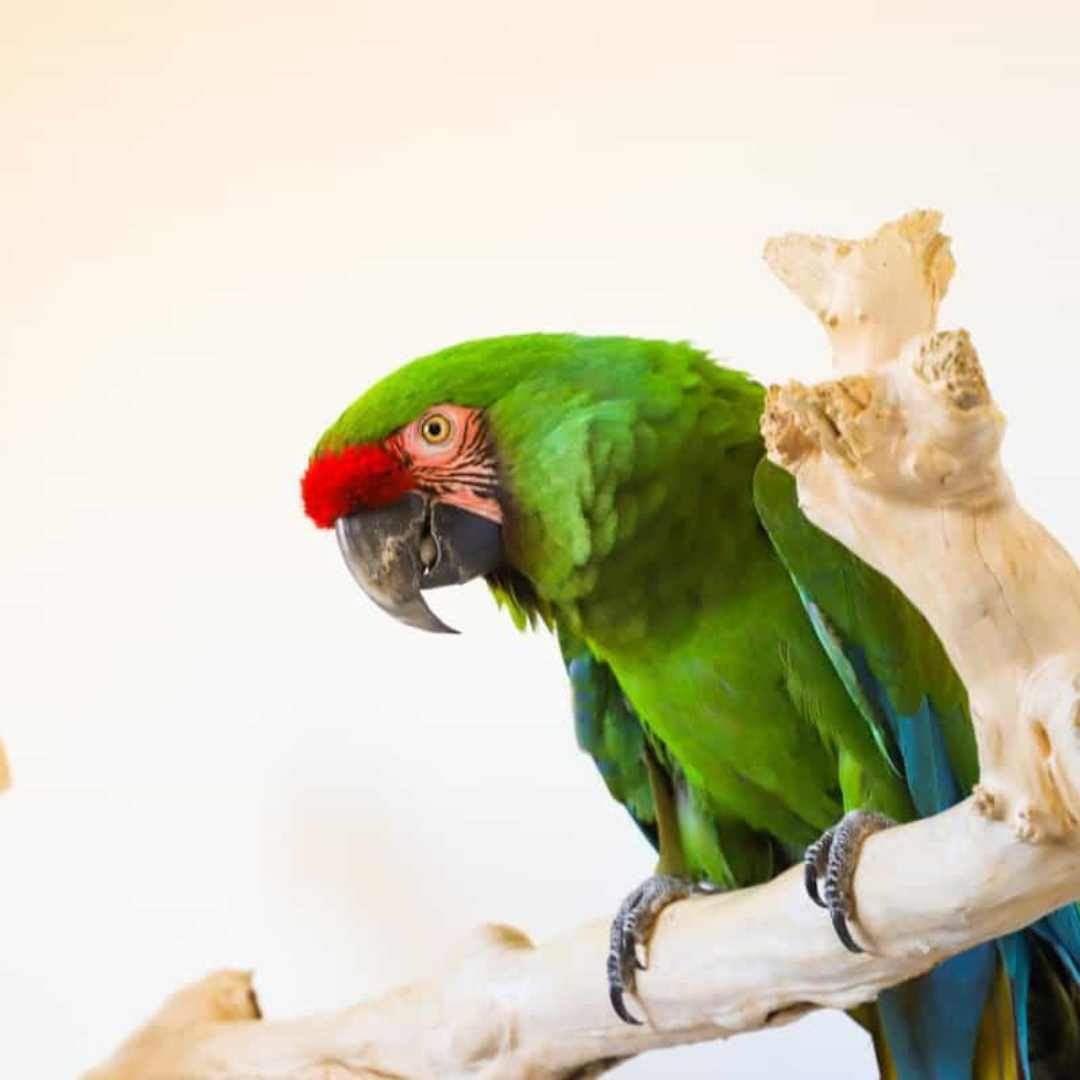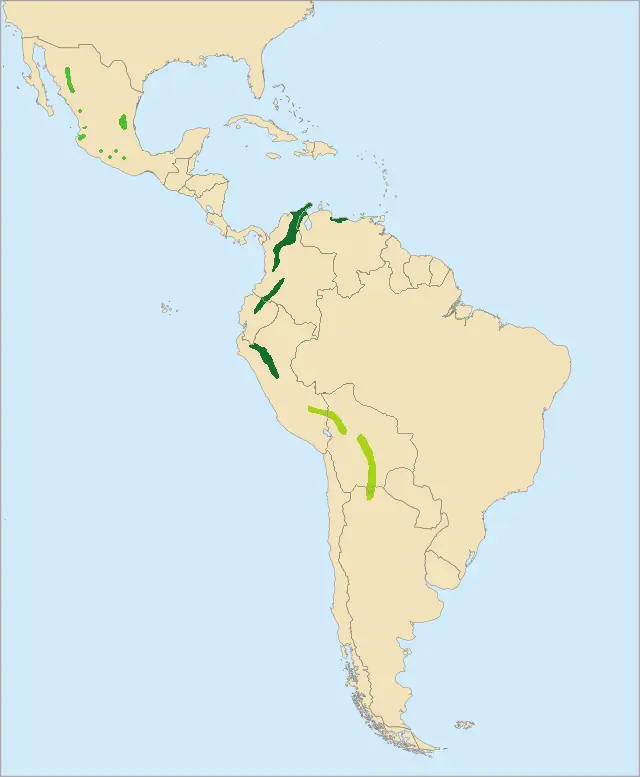Appearance
Military macaws are so-called because they were first brought to Europe by military personnel. It is also suggested that the name comes from the color of their plumage, being “army” or olive green. They may not be as impressive in looks as other macaws, but they are beautiful nonetheless. They are also social and fun-loving, and many of the ones kept as pets become excellent talkers.
Habits and Lifestyle
Military macaws live in pairs or family groups. They are also often seen in flocks with as many as 40 birds in communal roosts on cliff faces or in tall trees, where they go to sleep at night. They are very noisy and make themselves conspicuous at the time of dawn and dusk, while they fly between the roosting and feeding areas. During such flights, mating pairs fly close together. When at rest during the day, the birds perch on the tops of exposed dead trees. Military macaws migrate seasonally to eat particular fruits and move about locally in many regions. Their beaks are used as a “third hand” when they move about or climb in trees, enabling them to climb easily with the help of their feet and beak. Military macaws are often heard before they are seen, identified by their loud screeching and croaking.
Diet and Nutrition
Military macaws are herbivores (granivores, frugivores, folivores). They eat seeds, nuts, berries, and fruits, as well as other kinds of vegetation while they are up in a tree.
Mating Habits
Military macaws are monogamous, remaining together for life. During courtship, they perform aerobatics as part of flight displays. The breeding season takes place between January and March, though it may vary depending on the country. They nest in cavities, mostly in a hole in a treetop, but also in canyon cliff-faces, where their nest may be set up in rocky crevices or fissures, about 200 m off the ground. 2 or 3 white eggs are laid. Incubation is about 28 days to a month, by the female, who is fed by the male during this period. The male then brings her food for their chicks. The young fledge at about 12 weeks old. Military macaws reach reproductive maturity after two to four years.
Population threats
The main cause of the huge decline in the number of Military macaws is the pet trade. Loss of habitat is another significant reason for the reduction of their numbers, through deforestation for agriculture and cattle ranching.
Population number
According to the IUCN Red List, the total population size of the Military macaw is 3,000-10,000 individuals, which includes 2,000-6,666 mature individuals. Currently, this species is classified as Vulnerable (VU) on the IUCN Red List and its numbers today are decreasing.
Ecological niche
Military macaws have an important role in spreading seeds for the plants, fruits, and berries that they eat.
The IUCN judges that the Military Macaw is Vulnerable, and there is some lack of clarity on the likely overall population size of this species, with estimates made in 2016 ranging from as low as 1,000 breeding pairs to as high as 10,000 individual birds.
There are two main threats to the species, as it is trapped at high levels for the pet trade as well as being affected by habitat loss. Where the macaws nest in tree cavities, these nests are very vulnerable to poaching. It was estimated in 2002 that 23 per cent of suitable habitat in Mexico had been lost, and only a small proportion of the species’ range in Mexico falls within a protected area, though the population in the Sierra Gorda Biosphere Reserve is thought to be reasonably viable.
As it uses agricultural land, it may also be persecuted as a pest in these areas.
Physical Description
Tigers have reddish-orange coats with prominent black stripes, white bellies and
white spots on their ears. Like a human fingerprint, no two tigers have the exact
same markings. Because of this, researchers can use stripe patterns to identify
different individuals when studying tigers in the wild. Tigers are powerful hunters
with sharp teeth, strong jaws and agile bodies. They are the largest terrestrial
mammal whose diet consists entirely of meat. The tiger’s closest relative is the lion.
In fact, without fur, it is difficult to distinguish a tiger from a lion.
Size
Tigers are the largest cat species in the world, and the Amur tiger is the largest
subspecies with males weighing up to 660 pounds (300 kilograms) and measuring 10
feet (3 meters). Sumatran tigers are the smallest subspecies, maxing out at 310
pounds (140 kilograms) and 8 feet (2.4 meters). Female tigers of all subspecies tend
to be smaller than their male counterparts.
Native Habitat
Historically, tigers existed throughout much of Eastern and Southern Asia, as well as
in parts of Central and Western Asia and the Middle East, surrounding the Caspian
Sea. Their range has diminished significantly as human populations have expanded.
Itis believed they currently occupy just 7 percent of their historic range.
Presently, tigers are found in a variety of habitats across South and Southeast Asia,
China and Eastern Russia. They thrive in temperate, tropical or evergreen forests,
mangrove swamps and grasslands. Amur tigers are primarily found in Far-East
Russia, although there are small populations across the border into China and
potentially North Korea. Sumatran tigers are found only on the Indonesian island of
Sumatra. A tiger’s range within these regions is determined by the availability of
prey.
Communication
Despite their solitary nature, communication is a very important part of tigers’
behavioral ecology. They communicate through vocalizations, such as roaring,
grunting and chuffing, and through signals, such as scent marking and scratches on
trees. Tigers are fiercely territorial animals, so these signals are particularly
important to communicating where one tiger’s home range ends and another’s
begins.
Food/Eating Habits
Tigers are solitary ambush predators that rely on stealth and strength to take down
prey. These apex predators primarily hunt large ungulates, such as wild boar and
deer, but are also known to consume monkeys, buffalo, sloth bears, leopards and
even crocodiles. When tigers are found in close proximity to humans, they may also
feed on domestic animals, such as cattle or goats. Tigers are adept swimmers and
have even been recorded hunting in the wild.
These powerful cats hunt primarily at night, using sight and sound to identify prey.
Their striped coats help them blend into their surroundings, where they lie in wait for
prey to pass by. At the opportune moment, tigers pounce on their prey, take it to the
ground and finish the kill by breaking or biting the neck. Tigers hunt about once a
week and consume as much as 75 pounds (34 kilograms) of food in one night.
At the Zoo, tigers eat ground beef, and their diet is supplemented with enrichment
items each week. They receive knucklebones or cow femurs twice a week and rabbits
once a week to exercise their jaws and keep their teeth healthy.
Social Structure
Tigers are solitary creatures, except when mating or raising young. Cubs stay with
their mothers until they learn to hunt successfully, usually at about 18 to 24 months
old. They reach full independence after two to three years, at which point they
disperse to find their own territory. Female tigers often remain near their mother’s’
territory, while males disperse farther from home.
Reproduction and Development
Female tigers reach sexual maturity between age 3 and 4. Males are sexually mature
at about 4 or 5 years old. Mating can occur at any time of year but most often takes
place during cooler months between November and April. Tigers are induced
ovulators, which means females will not release eggs until mating occurs. Gestation
lasts approximately 100 days, and females give birth to between one and seven
offspring at a time, averaging between two and four cubs. Once cubs become
independent, at about age 2, females are ready to give birth again. However, if a
female’s offspring do not survive, due to causes such as infanticide or starvation, she
is able to conceive another litter right away.
Lifespan
The life span of tigers in the wild is usually between 10 and 15 years. In human care,
or on rare occasions in the wild, a tiger can live up to 20 years. However,
approximately half of all wild tiger cubs do not survive past the first two years of life.
Only 40 percent of those that reach independence actually live to establish a territory
and produce young. The risk of mortality remains high for adult tigers due to their
territorial nature, which often results in direct competition with conspecifics, or
members of the same species.













